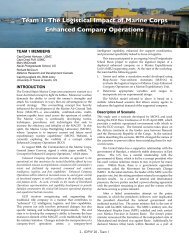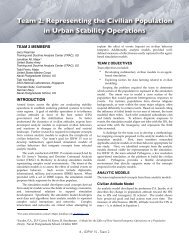pdf file - SEED Center for Data Farming - Naval Postgraduate School
pdf file - SEED Center for Data Farming - Naval Postgraduate School
pdf file - SEED Center for Data Farming - Naval Postgraduate School
You also want an ePaper? Increase the reach of your titles
YUMPU automatically turns print PDFs into web optimized ePapers that Google loves.
Figure 1: Initial setup of the scenario; the position of the IED among the civilian group is marked<br />
model realistic human behavior and comprehensible actions<br />
and reactions to IED explosions.<br />
The workgroup was driven by guiding questions such as:<br />
• What effects do IED explosions have on human<br />
behavior?<br />
• Have the relevant factors and elements characterizing<br />
such a situation been identified and captured in the<br />
current modeling of the agents' behavior?<br />
• Can an IED detonation lead to aggressive behavior<br />
among the civilians? If yes, what are the reasons and<br />
when does aggression start to dominate the situation?<br />
STUDIES & ANALYSES<br />
As a first step, we investigated the effects that differentlysized<br />
IEDs had on the surrounding agents. This ef<strong>for</strong>t also<br />
served as verification <strong>for</strong> the new implementation of IEDs in<br />
PAX and the effects of detonations on human agents, as we<br />
were able to verify that different sizes of IEDs do indeed lead<br />
to a respective increase or decrease in injury and death<br />
within the model.<br />
Experiment 1 Setup<br />
In the model, the damage caused by an IED explosion is<br />
expressed in so-called "kill levels". Every kill level defines a<br />
type of damage it can cause, a probability with which this<br />
damage is actually caused, and a diameter around the center<br />
of the detonation inside which the kill level can cause that<br />
damage. The diameters (defined in meters) of the kill levels<br />
determine their mean areas of effectiveness (MAEs).<br />
In this experiment we distinguished three types of kill<br />
level MAEs:<br />
• MAE_CompleteKill: Agents inside this area can be<br />
killed by the detonation.<br />
• MAE_MobilityKill: Agents inside this area can be so<br />
heavily injured by the explosion that they are unable<br />
to move afterwards.<br />
• MAE_GeneralKills: Agents inside this area can suffer<br />
injuries that reduce their overall health, but do not kill<br />
them or leave them immobilized.<br />
For our experiments, we generated IEDs of different sizes<br />
by modifying their respective MAEs. Table 1 shows the ranges<br />
we varied <strong>for</strong> each IED size. The resulting ten different sizes of<br />
IEDs were consecutively numbered "IED size 1" to "IED size<br />
10". For simplification, variation of an IED's damaging power<br />
was done solely by this modification of the MAEs, while the<br />
kill probability inside every MAE was fixed to a value of 80%<br />
throughout all our experiments.<br />
MAE_<br />
CompleteKill<br />
(diameter)<br />
MAE_<br />
MobilityKill<br />
(diameter)<br />
MAE_<br />
GeneralKills<br />
(diameter)<br />
IED size<br />
2 3 4 1<br />
4 6 8 2<br />
… … … …<br />
20 30 40 10<br />
Table 1: Definition of IED sizes by modification of the MAE<br />
diameters of the different kill levels<br />
Figure 2 shows a visual representation of the various kill<br />
levels and their MAEs <strong>for</strong> the largest IED that was used in our<br />
experiments.<br />
10 - IDFW 20 - Team 3




